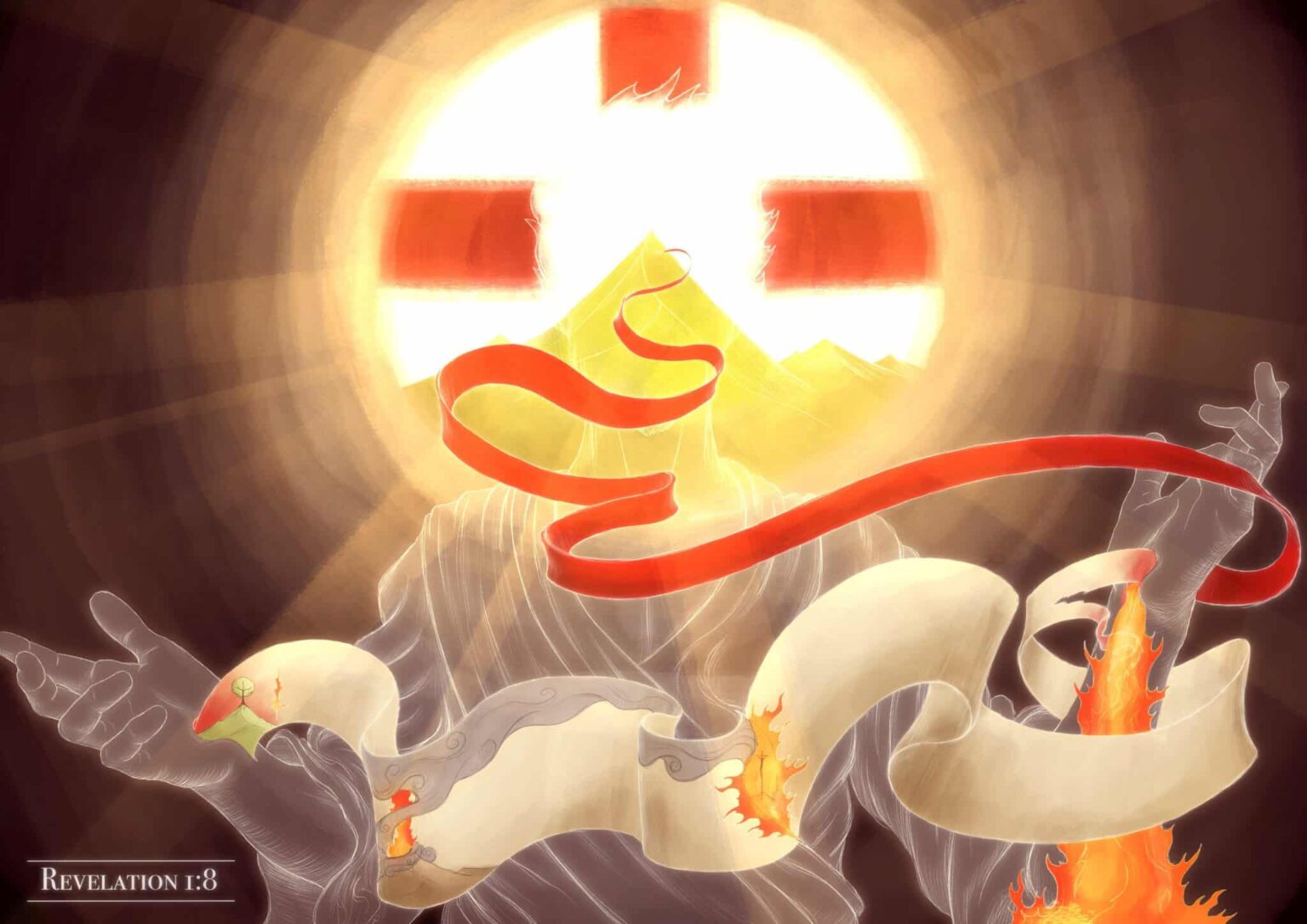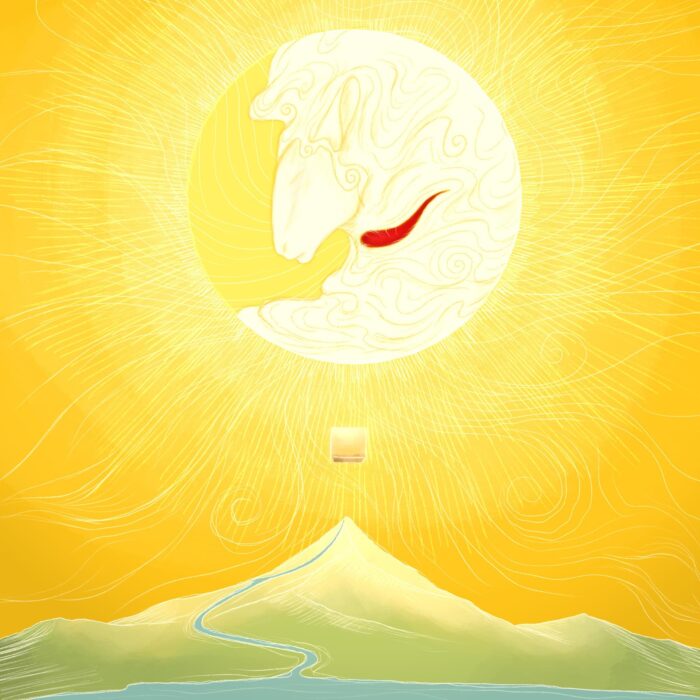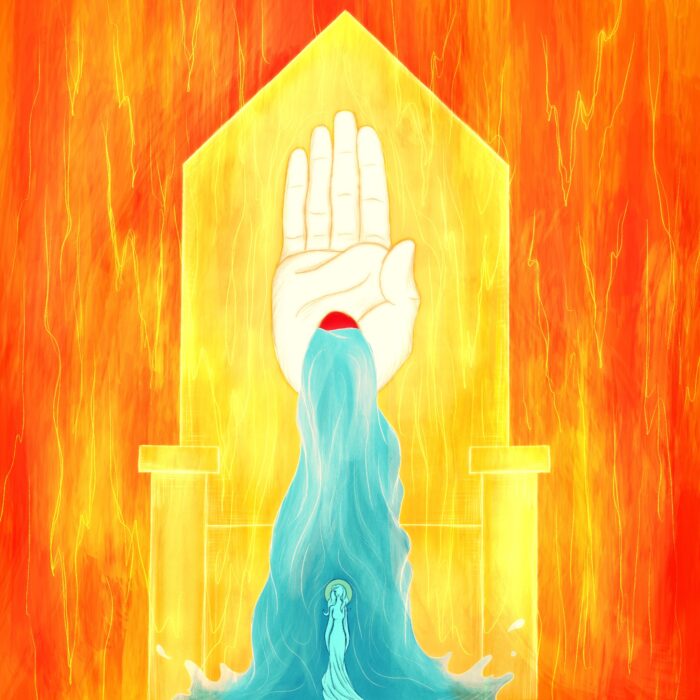
“‘I am the Alpha and the Omega,’ says the Lord God, ‘who is and who was and who is to come, the Almighty.”
– Revelation 1:8
The Passage Explained
Not only does Revelation 1:8 function as the climax to John’s trinitarian greeting, but it also works as something of a thematic foundation for the rest of the book. The One True God, from whom, through whom, and to whom all things are, is at the heart of Revelation, and this verse establishes that truth from the very beginning. Before talking about the image derived from this text, I want to briefly touch on a few notes of importance in the verse itself.
The very first thing we see is an allusion to the divine name “YHWH.” The “I am” in verse 8 translates the Greek phrase “εγώ ειμι” which directly echoes God’s self designation to Moses in the Greek version of Exodus 3:15ff. Now, the presence of “εγώ ειμι” alone is not enough to justify an allusion to the covenant name of YHWH, but when it comes–as it does here–in the context of divine self-declaration, the connection seems legitimate. The God of Revelation is the God of Genesis, the Lord who creates the New Heavens and New Earth is the same who spoke the first “Let there be…”, and the God who was “in the beginning,” is the God who will be there at the end.
Second, what does YHWH declare about Himself? That He is the “Alpha and Omega,” which is to say, the first and the last the beginning and the end. He is the one who encompasses all of time and history as the source and goal of all things. This means that the story of history has YHWH as it’s author and YHWH as its finisher. Though history–like the book of Revelation–passes through dark chapters, it will–again, like Revelation–end as it began, to the glory of God in Christ. As a side note, for those who have come to know YHWH in Christ as Lord, God, treasure, and life, this means that our personal story begins and ends (though it never really ends) in joy.
Its also important to recognize that there can only be one true beginning and end, one true “Alpha and Omega.” If there is anything before Him, then He is not the beginning, and if anything has a final say after Him, then He is not really the end. If YHWH is Alpha and Omega, He is the only Alpha and Omega. I mention this because in Revelation 21:13, Jesus refers to Himself as the “Alpha and Omega, the first and the last, the beginning and the end.” The fact that both the crucified and risen Christ and the Almighty of God use this self designation is strong evidence for the orthodox position that Jesus is fully God, one with the Father, and truly given the name of YHWH. Jesus is God, and Revelation 1:8 helps us see this.
Next we see another self designation that points to YHWH’s transcendence and deity, He is the one “who is and who was and who is to come.” The most obvious meaning of this title is that the One True God is eternal, existing from everlasting to everlasting, unbounded by time and space and so utterly and uniquely free to order the unfolding of creation as He pleases. This is a fitting title for YHWH to assume at the beginning of a book proclaiming the climax of human history. Whatever is to come, we know that YHWH is Lord over it all.
But I think there might be another implication bound up in this title. The designation “who is who was and who is to come” is found first in Revelation 1:4, and then again here in 1:8. The same title (albeit with the position of “who is” and “who was” being swapped) appears in 4:8. However, after that we see a change. In Revelation 11:17-18 we read that the “Lord God Almighty, who is and who was” has taken His power and begun to reign. Interestingly, the phrase, “who is to come” is dropped. Can we make any sense of this? I think we can.
Notice that the praise of 11:17-18 is being given to God at a moment when He is decisively acting in history. He is, at last, taking His power and beginning to reign so that, as we read in verse 15, “the kingdom of this world has become the kingdom of our Lord and of his Christ and he shall reign forever and ever.” What’s more, verse 18 tells us that God’s wrath came (the same Greek word used in the phrase, “who is to come”). It seems to me that the designation “who is to come,” may be a looking forward to God’s coming in wrath and power to make the kingdoms of the world the kingdoms of Christ. Once He has begun to act in this way–as He has in 11:17-18–He is no longer the one “who is to come,” since He has come. This seems to be further corroborated by 16:5 which again leaves off the “who is to come” and is again in a context of eschatological judgment. With these things in mind it seems to me that the title, “who is, and who was, and who is to come,” not only points to YHWH’s temporal transcendence, but also to the surety of His decisive judgment within space and time that will establish His kingdom under the reign of His Christ.
Finally, we read that He is the “Almighty.” YHWH, the One True God, is the sole ruler over all things and He will be recognized as such in the reign of the risen Lamb. Perhaps a good restatement of Revelation 1:8 in a way that draws out the points made above would be:
“The I AM, the Author of all things who will make joy the unending song of His people, the eternal one who is coming in blood-borne, blood-bought wrath to manifest Himself in His slain and risen Son as the sole ruler of the universe.”
So how do these concepts find expression in this picture?
The Picture Explained
Though the One True God is Triune–Father, Son, and Spirit–the Son is the one who reveals God to creation. Thus, YHWH is definitively revealed not in the burning bush or through the divided sea or on the smoke-veiled mountain, but in the person of the crucified and risen Son. Because of this the outlines of a human form–representing the incarnate Son–are pictured. When we read of the “I Am”–as we do in this text–we ought to think most definitively of the biblically revealed man, Christ Jesus.
As we saw, the title “Alpha and Omega,” points to YHWH’s transcendence and sovereignty over history. To highlight this I pictured the timeline of creation as a scroll, implying that it is a story with an author, not a haphazard collection of random events. The scroll’s source is in the wound in Christ’s right hand to show both that creation was an act of love and that–if it’s goal was to communicate the fullness of God’s glory–it would entail the sacrificial death of the Creator. The joyful “ending” of history for the saints is pictured by the red scroll (red because every moment of joy in eternity is blood-bought, Ephesians 2:4-7, Revelation 5:9-10, 7:14, this is also why the cruciform halo is prominently featured over the vision of the saints eternal destiny) the red scroll that passes through the wound of Christ ‘s left hand and on toward the green mountains of the New Heavens and Earth. The new creation is represented as being within the face of Christ since it will be the knowledge of YHWH, as made known in the Son, that will one day infuse all of reality with eternal joy for the saints (Isaiah. 11:9. Revelation 21:23). This is what it means for YHWH to be the Alpha and Omega.
YHWH’s designation as the one who is, was, and is to come is pictured not only by Christ’s holding all of history literally between his hands, but also by the final outpouring of wrath that is spent on on those who have opposed the triune God to the end. I pictured wrath as fire in this image and you can see that it begins with the fiery sword that blocks the way to the tree of life. We see it again on Sinai when God descended in holy fire on the mountain. After Sinai, we see wrath poured out in full on Calvary (the wound at the center of the scroll). For those trusting Christ, Calvary was our judgment day, Golgotha was our “end of the world,” the death of Jesus was our damnation….and so I pictured fire prominently here. However, for those who continue to oppose the Triune God even to the end, wrath will be poured out on them in hell, and it will be poured out by the same hands that bore it on the cross. Thus the final judgment against the unbelievers is pictured as a stream of fire issuing from the wound in Jesus’ left hand. For the unrepentant enemies of God, Jesus’ death is the final condemnation since it witnesses to the infinite weight of their sin and the infinite ransom which they have spurned.
Lastly, the title of “Almighty” is represented by the complete picture. The One True God declares Himself to be the Almighty Lord of the universe through the revelatory redemption that He carries out from one end of history to the other. And this work of self-revealing redemption centers around and climaxes in the person and work of His crucified and risen Son. By representing Jesus as the source, centerpiece, and goal of creation history, and by picturing the work of His death and resurrection, applied both to the elect and the non-elect, I was trying to visually say, “In the incarnate Son, YHWH, the One True God, is the Almighty ruler of the universe.”




